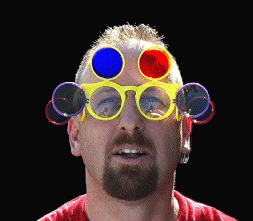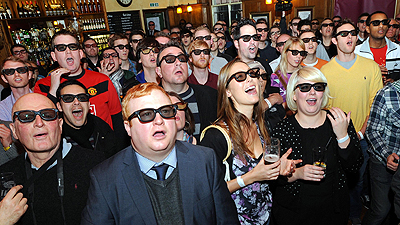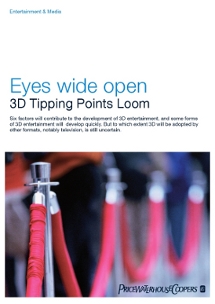2D (not 3D) Glasses
 We’ve all heard about 3D glasses. There are so many varieties that Rainbow Symphony offers so-called “Ultimate 3D Glasses” (shown here). They work with many, but by no means all, forms of 3D. Here’s a link to their site: http://www.rainbowsymphony.com/ultimate-3d-glasses.html
We’ve all heard about 3D glasses. There are so many varieties that Rainbow Symphony offers so-called “Ultimate 3D Glasses” (shown here). They work with many, but by no means all, forms of 3D. Here’s a link to their site: http://www.rainbowsymphony.com/ultimate-3d-glasses.html
But, since January 11, I’ve been writing about 2D glasses, rather than 3D. I’ve decided to consolidate my posts on the subject into one.
It began with a story in the UK Telegraph on January 11. The story was headlined “Do 3D films make you sick?” http://www.telegraph.co.uk/health/6952352/Do-3D-films-make-you-sick.html
It was by no means a condemnation of 3D, and it clearly noted it was referring to a minority of viewers, but it stated that “a significant minority of the population cannot sit through a 3D film without experiencing discomfort.” Those are viewers in cinemas, where issues of visual accommodation-vergence conflict are minimal (see my post “3DTV: Home and the Range” about the more significant issues in homes: http://schubincafe.com/blog/2009/11/3dtv-home-and-the-range/).
So I posted the following about the Telegraph article that day:
“That’s a problem worth noting. Shutting one eye [without glasses] won’t help; the other will still see a double image. And the same individuals could have a problem when put in front of someone else’s 3D TV.
“There is an obvious solution: glasses that send the same single view to both eyes.”
The next day, the New York Daily News ran a similar story, indicating that the problem is not unique to the UK. It was headlined “Little too reel-istic: Mega 3-D hit ‘Avatar’ gets great reviews but gives some viewers motion sickness.” It, too, referred to a significant minority experiencing adverse reactions — sometimes so adverse that they had to stop viewing the movie: http://www.nydailynews.com/lifestyle/health/2010/01/12/2010-01-12_little_too_reelistic_mega_3d_hit_avatar_giving_some_motion_sickness.html
Then, on January 15, cnet.com writer Rafe Needleman wrote of being stereo-blind and watching Avatar in a near-empty auditorium showing the movie in a non-3D version. He added, “While I find viewing 3D imagery uncomfortable, Daniel Terdiman, another person at CNET who can’t see 3D, saw the 3D version of Avatar and wore the 3D glasses. It looked fine to him, just not 3D.” http://news.cnet.com/8301-19882_3-10435478-250.html
So it might seem this is a non-issue. Those who can’t see 3D but aren’t bothered by it put on 3D glasses, and those who do have a problem with 3D watch a 2D version.
Unfortunately, the latter might not be an option. On January 18, the Los Angeles Times reported that China was pulling the 2D version of Avatar from theaters, allowing only the 3D version to continue to be shown: http://latimesblogs.latimes.com/entertainmentnewsbuzz/2010/01/avatar-pulled-from-2d-screens-by-chinese-government.html
It’s not necessary to go to China to have the problem. In my neighborhood multiplex in New York City, Avatar is available in plain 3D or IMAX 3D, but it’s not available in a non-3D version.
 When all of the TVs in a sports bar show a game in 3D, as was the case when Sky carried the 3D version of Arsenal vs. Manchester United to the Railway Tavern pub in Central London on January 31, what happens to the 3D-sickness prone? Do they chalk their feelings up to too much ale and bangers? Naturally Sky’s story about the event, where this photo appeared, doesn’t mention the issue: http://news.sky.com/skynews/Home/Technology/Live-3D-Sport-In-Pubs-Manchester-Uniteds-3-1-Win-Over-Arsenal-Kicks-Off-New-Era-Of-Broadcasting/Article/201001415539347?lpos=Technology_First_Home_Page_Feat
When all of the TVs in a sports bar show a game in 3D, as was the case when Sky carried the 3D version of Arsenal vs. Manchester United to the Railway Tavern pub in Central London on January 31, what happens to the 3D-sickness prone? Do they chalk their feelings up to too much ale and bangers? Naturally Sky’s story about the event, where this photo appeared, doesn’t mention the issue: http://news.sky.com/skynews/Home/Technology/Live-3D-Sport-In-Pubs-Manchester-Uniteds-3-1-Win-Over-Arsenal-Kicks-Off-New-Era-Of-Broadcasting/Article/201001415539347?lpos=Technology_First_Home_Page_Feat
In fact, if things work out as consumer-electronics manufacturers wish, it won’t be necessary to leave one’s home to have the problem. The various mechanisms proposed for the distribution of 3D to the home usually offer a way to display just the left eye’s view as a 2D version. But that works only if everyone wants to see the non-3D version.
If three people in a family of four want to watch a movie at home in 3D, and the fourth finds that sickening, do they banish that relative? If one relative at  Thanksgiving or neighbor at a Super Bowl party can’t see 3D, does the host withdraw the depth effect from all the others?
Thanksgiving or neighbor at a Super Bowl party can’t see 3D, does the host withdraw the depth effect from all the others?
Just how big is the “significant minority”? In November, PricewaterhouseCoopers (PwC) issued a report, “Eyes Wide Open: 3D Tipping Points Loom.” Page 17 lists, as the top two factors that could limit 3D adoption, that “Approximately 20% of the people who attended a 3D movie did not like it, citing eye fatigue, the eyeglasses and other issues,” and “About 5% of people are ‘stereoblind’ and cannot see in relief.” The full report may be downloaded here: http://www.pwc.com/en_GX/gx/entertainment-media/pdf/Eye_Wide_Open_3D_Tipping_Points.pdf
I should note here, as I did in my “Home and the Range” post, that not all stereoblindness and 3D discomfort is necessarily permanent. In addition to just the training effects of viewing 3D, some professionals specialize in treatment. Here’s the 3D treatment page of the College of Optometrists in Vision Development: http://www.covd.org/Home/3DStereoVision/tabid/258/Default.aspx
If, however, training and treatment don’t help, and non-3D versions aren’t available, a solution is 2D glasses. The principle behind 2D glasses is relatively simple. Just send the same eye’s view to both eyes. In practice, it’s not necessarily all that easy.
In systems sending views alternately to each eye, a 2D-glasses viewer would see pictures only half the time (and, in the case of active-shutter glasses, might have to pay a lot for the privilege). In systems that require the visual system to reconstruct color from the two eyes’ views, a 2D-glasses viewer would not get full color.
In systems using simple, linearly polarized simultaneous views, however, a 2D-glasses viewer would get color images all of the time. The only requirement is that both lenses be polarized the same way, instead of at 90-degree angles to each other.
There’s actually a very old precedent for this idea — and for the idea of different family members getting different experiences from the same TV set. It is DuMont’s 1954 Duoscopic TV. The device combined the images from two picture tubes via polarizing filters. The two tubes could be displaying different shows. Family members were to wear polarized glasses — 2D polarized glasses — for the show they wanted to see and to listen via earphones. When Popular Science wrote up the system in March 1954, they pictured even the family dog wearing glasses.
 The rest of this picture and the Popular Science article are available at the excellent web site of the even-more excellent Early Television Museum near Columbus, Ohio, well worth a visit, especially during their annual convention: http://www.earlytelevision.org/dumont_duoscopic.html
The rest of this picture and the Popular Science article are available at the excellent web site of the even-more excellent Early Television Museum near Columbus, Ohio, well worth a visit, especially during their annual convention: http://www.earlytelevision.org/dumont_duoscopic.html
Tags: 2D, 2d glasses, 3D, 3d discomfort, 3d sickness, 3DTV, Avatar, College of Optometrists in Vision Development, DuMont Duoscopic, Early Television Museum, eye fatigue, Sky 3D, stereoblind, stereoblindness, ultimate 3d glasses,

No comments yet. You should be kind and add one!
The comments are closed.